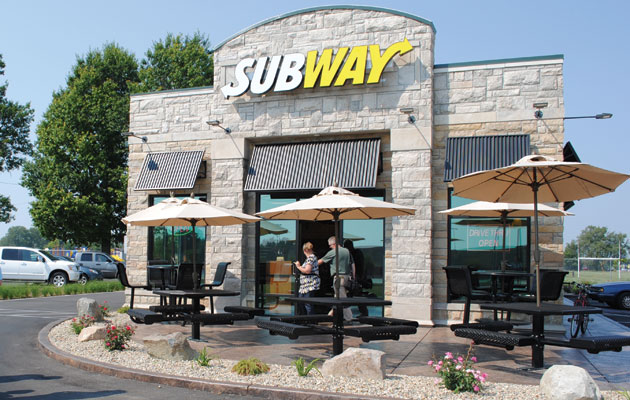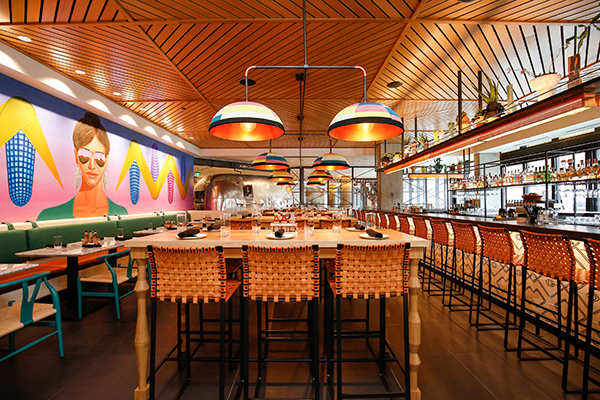With the prevalence of eco-friendly builders, architects, suppliers and products, restaurant chains can choose from a variety of options that suit their needs as their systems look to expand in an environmentally friendly way.
For Subway franchisee George Estep, simultaneously building an eco-friendly store in Kokomo, Ind., and a traditional site 65 miles away in Muncie, was a real eye-opener. By appearance alone, the two free-standing restaurants with drive-thru access seem virtually identical.
A closer look reveals subtle, yet substantial, differences.
The green building was constructed using recycled materials, including reused Indiana stone on the exterior. The design of a white membrane not only assists in migrating heat away from the building, but it also diverts rainwater into the soil.
Inside, a computerized energy savings unit in the dining room features a display that informs staff of energy spikes. With this system, lights automatically turn on and off, depending on the amount of sunlight generated in the front of house. A visit to the restrooms reveals dual-flush toilets that monitor water usage and sinks with motion sensors. The restaurant also features interior and exterior LED lighting and an energy-recovery ventilator that works in conjunction with the building's air exhaust system to improve inside humidity and reduce utility costs. The high-efficiency HVAC system provides additional energy savings.
With both projects in progress at the same time, Estep was able to easily break down the additional costs of going green, which he says totaled between $26,000 and $28,000. "This was my first green site, so I was nervous not knowing what additional costs were involved," he says. "Now that I know, the only thing I would have done differently is to have made the Muncie site eco-friendly, too. I'm still kicking myself."
Although Estep does not yet know the total return on investment, he says the Kokomo location saves $600 a month on electricity and water costs alone. "Those who understand the math will want to build green," Estep says. "Operators pay a bit more up front to save substantially on the back end."
Certification Options
Even during this economic downturn, where finding the funds to open a restaurant of any type represents a challenge, more operators continue to realize the benefits of going green.
The Green Restaurant Association (GRA), a Boston-based nonprofit organization that provides tools and certification for operators seeking to build environmentally friendly restaurants, reports that the number of restaurants seeking green certification triples each year. "Instead of calling us a month or two before opening, we're now hearing from operators six to nine months out," says Michael Oshman, GRA's founder and CEO. "We attribute this to the awareness of sustainable design vastly increasing in the restaurant industry."
To earn certification from the GRA, restaurants must accumulate at least 10 points in categories that include water efficiency, waste reduction and recycling, sustainable food, energy, disposables, and chemical and pollution reduction. Point allocations vary, from three points for an Energy Star-qualified dishwasher to 6.5 points for reusable napkins. Operations must also have a full-scale recycling program and be free of polystyrene. The GRA also requires ongoing education.
In addition, the GRA offers three certification levels, with 100 total points required for two-star certification, a minimum of 175 points needed for a three-star designation and at least 300 points necessary for four-star certification. The GRA's Sustainabuild designation includes specific scoring prerequisites and requires a total of 205 points.
The U.S. Green Building Council (USGBC), based in Washington, D.C., reports that a majority of quick-serve, and increasing number of full-serve, restaurants are experimenting with LEED (Leadership in Energy and Environmental Design) to determine what works and what doesn't. To assist the restaurant industry in streamlining its scalable certification process, the USGBC launched its LEED for retail rating systems and a LEED volume program in November 2010. The volume program scrutinizes building and equipment energy performance and includes a kitchen-efficiency requirement that monitors the operation of all units. McDonald's and Starbucks are two of the first participants in the LEED volume program.
"There are some pitfalls associated with LEED," says Nick Shaffer, USGBC's manager of commercial real estate. "Costs can seem higher initially, since there is new technology involved. But studies have shown that today's LEED certified projects cost the same as, or at maximum 2 percent more than, traditional designs."
Price misconceptions are not uncommon with LEED certification. In the past these projects were much pricier due to a shortage of materials, expensive new technology and other factors. During the past couple of years, though, costs have become competitive with non-green builds and renovations.
CKE Restaurants Inc., parent company of Carl's Jr., built its first green restaurant in January 2009. The Carpinteria, Calif., site includes solar panels, a parking lot with LED lights and a system that recaptures rainwater. It was not LEED certified. "Our architect at the time was not familiar with LEED, and the additional cost to become certified at that time was about $100,000," says David Luxton, vice president of construction and facilities for CKE Restaurants, who heads construction of the company's green units.
By the time the company planned a second green location in Culver City, Calif., which would open in June 2010 as its first LEED-certified site, these additional costs had decreased to $60,000. CKE opened its second LEED-certified location in Anaheim, Calif., which was its most affordable so far. "The city of Anaheim waved the plan check fee and gave us a green building rebate after we were certified," Luxton says. As a result, the total cost increase for the LEED Silver site was about $30,000.
"Architects are now more familiar with LEED," Luxton says. "Plus, the sustainable aspects of the projects, like LED light fixtures, are more accepted, available and, as a result, more affordable."
Along with LED lighting both inside and out, the sustainable sites Carl's Jr. operates incorporate solar tubes, which have eliminated $2,500 worth of lights. Solar reflective roofing material reduces the need for heating and cooling energy within the building. Electricity-saving energy management systems automatically control lighting and zone temperatures indoors. In addition to Energy Star-rated equipment, Carl's Jr.'s kitchens include charbroilers with catalytic converters that reduce smoke, odors and emissions by approximately
10 percent.
"We are now trying to develop tighter building envelopes to increase insulation and minimize air leakage," Luxton says. "We're also testing different energy management systems. The benefits of these are pretty stellar, from load shedding to demand monitoring."
Testing the Waters
About two years ago, Oak Creek, Wis.-based Bridgeman Foods, a 350-site franchisee for Chili's, Wendy's and other brands, conducted a green analysis of its Chili's sites, but found a number of obstacles to becoming certified by the USGBC.
"Due to the nature of our business, which is high-volume with a diverse menu, it was very difficult to get USGBC designation," says Lisa Kennedy, Bridgeman's director of design and construction. "I wish I had known more about the green building certification process. I didn't understand that we can do a lot and it's still not enough."
As a result, the company's initiatives became less structured as the priority changed from making every restaurant green.
One big obstacle was a lack of energy-efficient cooking equipment suitable for the company's concepts. Bridgeman also investigated changing its lighting. At that time, LED was still in its infancy. The lamps were pricey, and the technology was unreliable. Fortunately, this greener lighting has come a long way.
"Still, the percentage of energy use in lighting compared with equipment is insignificant," Kennedy says. "I'm not against saving on lighting, but to save that money for the return doesn't make as much sense as finding a more energy-efficient way to heat water, for example."
After the green analysis, Bridgeman began implementing environmentally friendly initiatives. The company uses Energy Star-qualified equipment whenever possible. Although not a priority at its current sites, new locations include LED lighting. "It's like developing healthy eating habits without going on a diet," Kennedy says. "We are evolving our restaurants in a smart, energy-efficient way."
By realizing what made sense for its operations, Bridgeman was able to analyze the biggest energy users and address those first. It also analyzed the return on investment. The company decided a 10 percent cost premium would be acceptable. "It's about what makes sense for each business," Kennedy says. "It's important to determine where the highest energy use is and go after what will provide the biggest bang for the buck."
Defining green initiatives up front helps better identify what will work. Bridgeman went to the extent of designing a solar water-heating system, but realized it was cost prohibitive and not practical. Operators also need to be aware that there are many supposedly green products and services being hawked these days that may not necessarily live up to their expectations.
"This was a learning process for us," Kennedy says. "We spent time up front doing our due diligence to learn about our building. This changed the way we look at all of our brands. Saving energy has impacted our bottom line, but we've also changed our thinking in terms of our responsibility to the planet."
Taking the Steps
The consensus among operators who have made the green commitment is that finding the right partners, from builders to architects to suppliers, is key to the project's success. Subway's Estep worked with Fortune Management, a green builder in Indiana that maintains a large warehouse of reusable materials for its projects.
"I worked with Scott Pitcher and his son Brandon, who is a leader in Indiana's green development," Estep says. "He was my mentor throughout the process."
Finding a builder that understands how to design a site that meets brand requirements represents the biggest challenge for franchisees of large chains.
"When we talk about brands and getting involved with green, the real connection begins with bringing together a green builder and an operator who wants to build green," Estep says. "Green builders need to attend franchise meetings to let operators know what they can do. Then the builder needs to unite with the franchisor and franchisee to develop a building and location that fulfills the green requirements."
With Estep's first project, the difficulties stemmed from building a 2,000 to 2,400-square-foot free-standing unit with a drive-thru around the necessary green requirements and Subway's franchise obligations. "It was a collaboration between myself, the builder and the land owner, since I lease the building," he says. "The restaurant industry needs to create a way to develop more green builders and then get the word out to all restaurant operators."
The process of creating eco-friendly restaurants continues to get easier. Larger chains like Subway keep adding green teams to assist franchisees with these initiatives. Currently, 14 of the company's 36,000 sites, all franchisee-owned, are eco-friendly.
"We have an internal certification process and assist franchisees in finding landlords who are seeking green tenants," says Elizabeth Stewart, Subway's marketing director and head of its corporate social responsibility efforts. "Fortunately, it's no longer difficult to find an eco-friendly architect."
Because store locations and formats vary significantly, Subway's green certification does not feature any standard requirements. Instead, franchisees are provided with a list of options from which to choose.
"Each option includes points that, when totaled, designate the sustainable level of the eco-store," Stewart says. "It is all dependent on what the franchisee can do with the location and what they're willing to put into it. For example, ventilating an HVAC unit outside is a great energy saver, but not every store can do this."
Subway provides points for sites located by mass transit or those utilizing solar panels or light tubes. Franchisees also have incorporated aerator sensors to reduce water usage in bathrooms. The chain continues to work with its vendors to reduce unnecessary packaging and has instituted a clean chemical program.
Subway's eco-friendly franchisees are seeing a return on their investment, but the financial impact varies depending on the restaurant size, product mix, traffic patterns and the elements that are put in place. "As we find environmentally friendly options that are more cost effective, we encourage franchisees to utilize these. We also will embed them into our standards when we can," Stewart says. Looking ahead, as green technology continues to advance and more environmentally friendly options become available, the bar continues to be raised.
At press time, the USGBC was currently in the final stages of refining its LEED rating systems for 2012, which will include LEED for retail, a general update to the rating systems requirements and new credit categories. "With LEED for retail, we are asking restaurants to develop and implement plans to track restaurant performance, which will be incredibly valuable for the industry," Shaffer says.
This information will provide insight into gas and electricity use via metering and recording devices.
During the past three years, green restaurant building has become more prevalent and the amount of leg work chains have to do to build more environmentally friendly locations is not as labor-intensive, according to several industry experts.
Shaffer agrees, anticipating that larger restaurant chains will build and design more LEED-certified sites. "Going green is a money-saver," Luxton says. "These projects typically provide a two-year payback, so it's a no-brainer to go this route."




